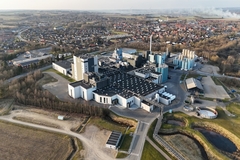
- Industry news
Industry news
- Category news
Category news
- Reports
- Key trends
- Multimedia
Multimedia
- Journal
- Events
- Suppliers
- Home
- Industry news
Industry news
- Category news
Category news
- Reports
- Key trends
- Multimedia
Multimedia
- Events
- Suppliers
ADM bumps up biomass fuel consumption, targeting significant energy cuts
 ADM.jpg)
01 Apr 2020 --- After meeting its “15x20” environmental benchmarks, which were met ahead of schedule, ADM has set out the groundwork to reduce its absolute greenhouse gas emissions by 25 percent and its energy intensity by 15 percent by 2035. FoodIngredientsFirst speaks to company executives to examine how these goals can be met through a revamped supply chain and manufacturing model. The ingredients manufacturer focalizes an increased use of biofuels using leftover crop material to power its systems.
“Our strategy to achieve the reductions include purchasing renewable electricity, increasing use of biomass fuels, transportation fleet changes, and in some locations, equipment changes,” says Alison Taylor, ADM Chief Sustainability Officer.

When asked to elaborate on ADM’s sourcing of biomass for fuel, Taylor explains, “Increasing the amount of biofuel burned onsite will reduce Scope 1 emissions. Part of the feasibility study included a review of biomass availability near our facilities capable of co-firing biofuel.”
 ADM.jpg) ADM’s canola plantation.“This is mainly corn stover left in the fields after harvest, rather than a crop grown specifically to be converted into a biofuel. At this time, with sufficient supply already in place, crop expansion for biomass is not anticipated to be necessary,” she notes.
ADM’s canola plantation.“This is mainly corn stover left in the fields after harvest, rather than a crop grown specifically to be converted into a biofuel. At this time, with sufficient supply already in place, crop expansion for biomass is not anticipated to be necessary,” she notes.
Renewable energy may be obtained through several pathways including power purchase agreements and contracts with renewable electricity generators. “Each region has different regulations on energy procurement, so a combination of strategies will be employed to obtain renewable energy purchases from the grid,” outlines Taylor.
Meanwhile, in both stationary and mobile equipment, ADM spotlights opportunities to switch to less carbon-intensive fuels. “Some facilities may feasibly be able to switch to natural gas or co-fire biomass in the boilers. Equipment changes may include different types of fleet vehicles or engine retrofits or replacements, boiler upgraders or replacements, biomass handling equipment installation, etc.,” says Taylor.
“We are also moving forward with several projects to use biodiesel in our fleet of boats and trucks. For example, we are assessing the use of liquefied natural gas for our boat fleet and compressed natural gas for our truck fleet in certain geographies,” she adds.
ADM’s expanded environmental ambitions come at a time when sustainability is increasingly expected of industry players, both small and large. Innova Market Insights research indicates that on average 85 percent of US and UK consumers expected companies to invest in sustainability in 2019, up from 64 percent in 2018. The market researcher has ranked “The Sustain Domain” as its third top trend for 2020.
 ADM.jpg) ADM’s soybean plantation.Taking ambitions a step forward
ADM’s soybean plantation.Taking ambitions a step forward
The new goals follow ADM’s “15x20” plan, unveiled in 2011, the company committed to per-unit improvements in energy use, greenhouse gas emissions, water and waste to landfill by 2020. After meeting its original targets ahead of schedule, ADM engaged WSP Global, an engineering professional services firm, to conduct an in-depth feasibility study to help shape a new set of commitments to combat climate change.
“We conducted a rigorous feasibility study to determine how ambitious our goals can be while still maintaining a pragmatic, realistic approach. These goals are backed by a thoughtful study of current technology capabilities, growth projections and the commitment of our leadership and employees,” explains Taylor.
“Our new goals are ambitious yet achievable,” comments Juan Luciano, Chairman and CEO of ADM. “The greenhouse gas emissions we’ll save will be the equivalent of those from charging every single smartphone on the planet 250 times. This is going to have a real impact, and is a key way in which we’re going to continue to give our customers an edge in meeting the market challenges of today and tomorrow.”
ADM’s new goals are detailed as “only only one element of a wide-ranging plan to pave the way on sustainability.” In 2019, ADM’s Board formed a new committee on Sustainability and Corporate Responsibility. The company is also increasingly using technology – such as satellite imagery – as it maps its supply chains. In December, ADM was shortlisted as a Sustainability Champion by the Food Ingredients Innovation awards for its work promoting and supporting sustainable agricultural practices among more than 12,000 smallholder farmers in Brazil and Paraguay.
Building upon the focus on greening up its sourcing and manufacturing practices, the supplier has been active in expanding its offerings within the plant-based space, which taps into a growing consumer appetite for slaughter-free and sustainable meals. Last August, it joined forces with Marfrig Global Foods, Brazil’s second largest food processor, for the production and sale of vegetable protein-based burger patties in Brazil.
“We know that the health of our natural resources are critical to our future. Consumers around the world know it as well, and they are making it clear that they expect their food and drink to come from sustainable ingredients, produced by companies that share their values,” Luciano concludes.
By Benjamin Ferrer










